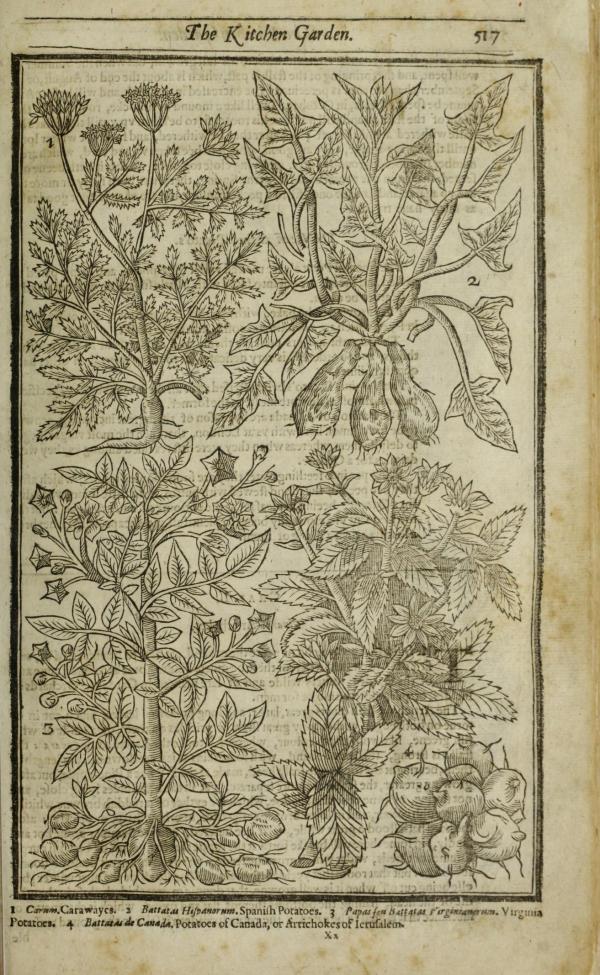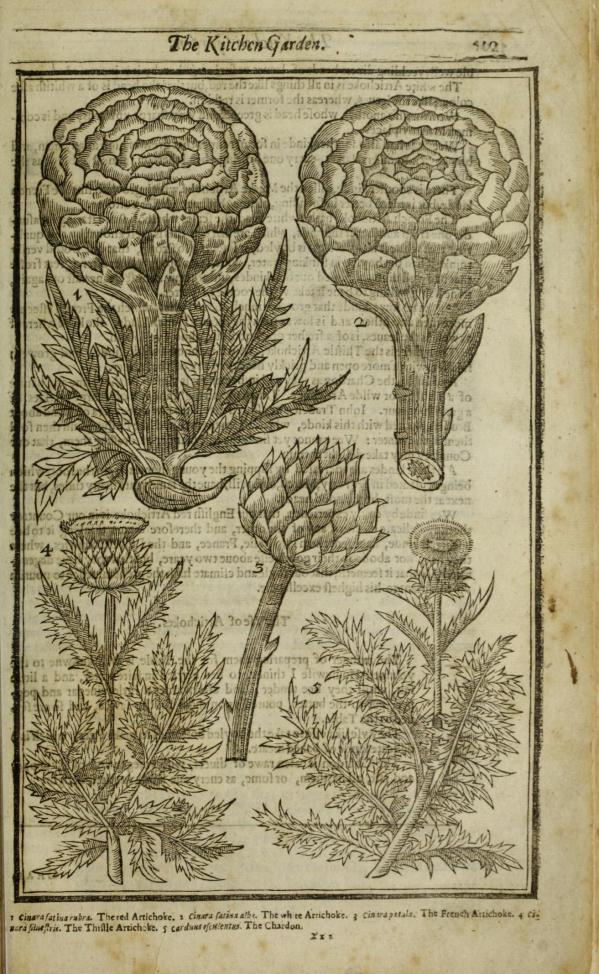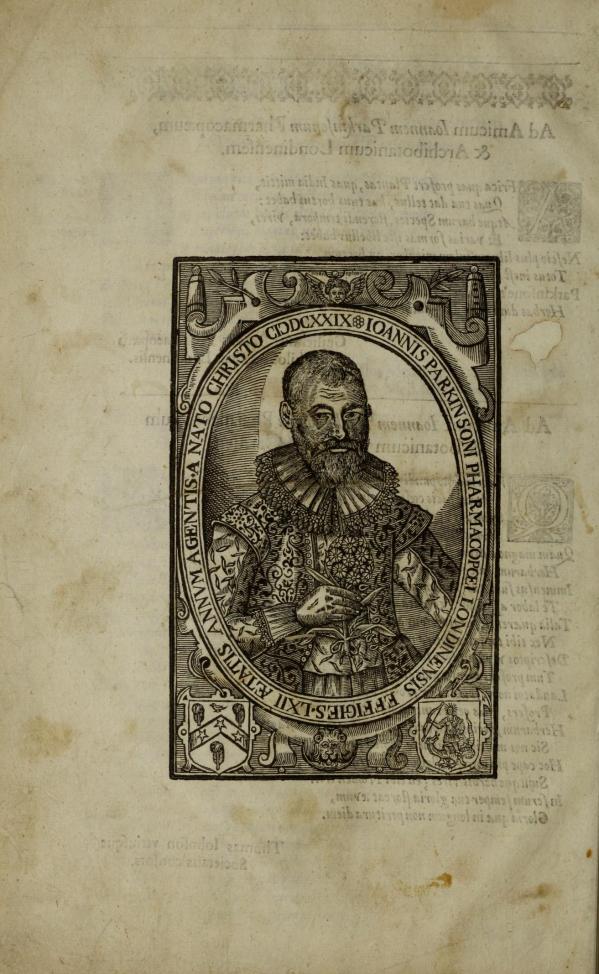
1. Brassica capitata Close Cabbage, 2. Brassica patula Open Cabbage, 3. Brassica sabandica crispa Curled Savoye Colewort, 4. Caulis florida Cole Flower, 5. Caulis crispa Curled Colewort, 6. Caulis crispa variata Changeable Curld Colewort, 7. Rapocaulis Cole Rape
At this time of year I feel a certain nostalgia for my old allotment. Late July would usually see a harvest of beans, courgettes, beetroot and lettuce. And if the crops were disappointing, there was always the consolation of blackberries which could be gathered in abundance in the hedges around the perimeter of the site.
These woodcut illustrations from John Parkinson’s Paradisi in sole paradisus terrestris (1629) convey the character of home grown vegetables so successfully. Many plants are drawn with their roots, foliage and flowers, giving a sense of their true scale, in contrast to the trimmed vegetables we find in supermarkets today. Bold, dark lines evoke the texture of the cabbage leaves and the strong artichoke stems bearing their enormous flower heads.
Written in English, Paradisi in Sole Paradisus Terrestris (or, Park-in-Sun’s Terrestrial Paradise) by apothecary and botanist John Parkinson, describes how English gardens were cultivated in the early 17th century. Divided into three sections Parkinson discusses the flower garden, kitchen garden and fruit garden with instructions how to ‘order’ or set these out, as well as giving advice about improving the soil, garden tools and the cultivation of plants. Most of the illustrations were original woodcuts by the German artist Christopher Switzer. Parkinson’s garden was in Long Acre, London, close to Trafalgar Square.
Parkinson has plenty of advice to those wanting to establish a kitchen garden, or garden of herbes and his first consideration is where this section of the garden should be situated. Parkinson has already suggested that the flower garden
‘be in the sight and full prospect of all the chiefe and choicest roomes of the house; so contrariwise your herbe garden should be on the one or other side of the house .. for the many different sents that arise from the herbes, as Cabbages, Onions, &c are scarce well pleasing to perfume the lodgings of any house;’
As well as the disadvantage of the smell of cabbages, Parkinson also points out that a kitchen garden is by its nature in a state of transition, with plants continually being sown and harvested, so it will not always always be neat and pleasing to look at – another reason for siting this garden away from the house:
‘As our former Garden of pleasure is wholly formable in every part with squares, trayles and knots, and to bee still maintained in their due forme and beautie: so on the contrary side this Garden cannot long conserve any forme, for that every part thereof is subject to mutation and alteration.’
As well as supplying the house with produce, another priority for Parkinson’s kitchen gardener is saving seed for future use. He recommends that the largest and best plants are chosen to set seed. Here he explains how to harvest seeds of lettuce
‘Before your Lettice is shot up, marke out the choysest and strongest plantes which are fittest to grow for seede, and from those when they are a foote high, strippe away with your hand the leaves that grow lowest upon the stalke next the ground, which might rot, spoyle or hinder them from bearing so good seede; which when it is neere to be ripe, the stalkes must be cut off about the middle, and layde upon mats or clothes in the Sunne, that it may there fully ripen and be gathered; for it would be blowne away with the winde if it should be suffered to abide on the stalkes long.’
As an apothecary, Parkinson is well placed to advise on medicinal or physicall herbes. He records that some country gentlewomen grow these herbs in sufficient quantity for their own families and to share with less well off neighbours.
‘These (herbs) are grown ‘to preserve health, and helpe to cure such small diseases as are often within the compasse of the Gentlewomens skils, who, to helpe their own family, and their poore neighbours that are farre remote from Physitians and Chirurgions, take much paines both to doe good unto them, and to plant those herbes that are conducing to their desires.’
The useful herbs Parkinson recommends include angelica, rue, chamomile, spurge and celandine.
The following images show some of the staple vegetables that would have been grown in 17th century England such as cabbages, root crops like carrots and parsnips, onions and leeks, together with more exotic introductions like potatoes and melons. There are also indigenous wild plants like goat’s beard which are no longer grown for food. The complete text can be found at the Biodiversity Heritage Library – see link below.

1 Cucumis longus vulgaris The ordinary Cowcumber. 2 Cucumis Hispanicus The long yellow Spanish Cowcumber. 3 Melo vulgaris The ordinary Melon. 4 Melo maximus optimus The greatest Muske Melon. 5 Pepo The Pompion. 6 Fragari vulgaris Common Strawberries. 7 Fragari Bohemica maxima The great Bohemia Strawberries. 8 Fragari aculeata The prickly Strawberry
Parkinson acknowledges that melons would be difficult to grow in the English climate and suggests a south facing slope with plenty of manure added to the ground.

1 Fabasatina Garden Beanes. 2 Phasioli satsui French Beanes. 3 Pisum vulgare Garden Pease. 4 Pisum umbellatum sine Roseum Rose Pease or Scottish Pease. 5 Pisum saccheratum Sugar Pease. 6 Pisum maculatum Spotted Pease. 7 Cicer arictinuum Rams Ciches or Cicers
Cicers or Ciches are chickpeas.

1 Raphanus rusticanus Horse Raddish. 2 Lepidium sine Piperitis Dierander. 3 copa rotunda Round Onions. 4 copa longae Long Onions. 5 Perrum Leekes. 6 Allium Garlicke. 7 Rapunculus Rampions. 8 Tragopogon Goates beard.
The roots of Goat’s beard or Jack Go to Bed at Noon were eaten cooked in butter. This plant is related to salsify.

1 Carum Carawayes. 2 Battatas Hispanorum Spanish Potatoes. 3 Papas seu Battatas Virginianerum Virginia Potatoes. 4 Battatas de Canada Potatoes of Canada or Artichokes of Jerusalem.

1 Sisarum Skirrits. 2 Pastinaca latifolia Parsneps. 3 Pastinaca tenuifolia Carrets. 4 Kapum Turneps. 5 (unclear) 6 Raphanus niger Blacke Raddish. 7 Raphanus vulgaris Common Raddish

1 Portulaca Purslane. 2 Dracho herba seu Tarchon Tarragon. 3 Eruca sativa Garden Rocket. 4 Nasturtium sativum Garden Cresses. 5 Sinapi Mustard. 6 Asparagus Asparagus or Sperage.
The nasturtium (4) does not look like the plant we think of as a nasturtium today.

1 Cinara satina rubra The red Artichoke. 2 Cinara satina alba the white Artichoke. 3 Cinara petala The French Artichoke. 4 Cinara silvestris The Thistle Artichoke. 5 Carduus osculentus The Chardon

Portrait of John Parkinson
Paradisi in sole paradisus terrestris (John Parkinson) at the Biodiversity Heritage Library. (The section about the Kitchen Garden begins on Page 461).

Thanks Sian! Another great insight into garden history
LikeLike
It is amazing how accurate some of those old seemingly silly looking illustrations can be. Some of the information that comes with them is more accurate than what can be found nowadays with so much more information so readily available online.
LikeLike